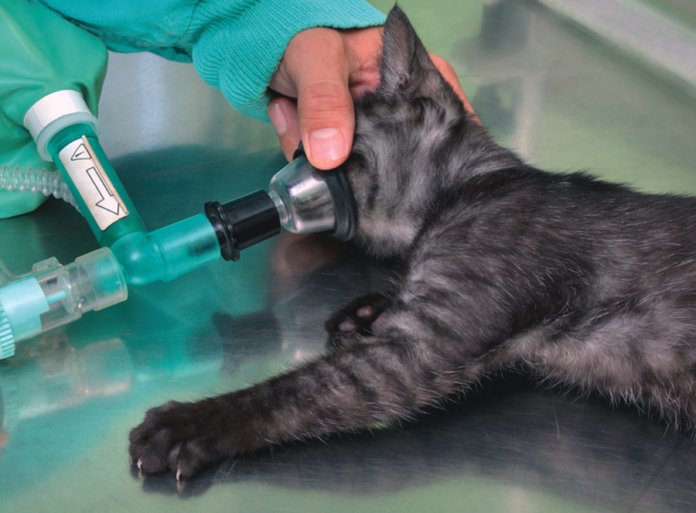General anesthesia is necessary for many procedures in cats, ranging from a routine spay, neuter, or dental cleaning to more involved mass removals or fracture repairs. Having your cat go under anesthesia can be scary, but the good news is that there is only an 0.24% risk of anesthetic death in cats1.
General Anesthesia
“Anesthesia” means “without sensation.” Usually when a member of your veterinary team mentions anesthesia, he or she is referring to general anesthesia, where your cat’s entire body is affected, and the cat is “asleep.”
When a general anesthetic is used, all of the pathways in the nervous system that transmit pain from its source to the brain remain intact, but the stimulus is blunted because the brain is asleep and the patient will not experience the pain. The attending veterinarian and/or an anesthesiologist selects the types of anesthetics and specific agents to be used depending on the patient’s age and general health, the nature of the procedure, which organs are involved, and the time required for the drugs to take effect.
When your cat is put under general anesthesia, she will be unconscious, with her muscles relaxed and no sensation of pain. There are also local anesthetics, which only block sensation in a limited area. Sedation falls in between being fully awake and fully unconscious and may be utilized for non-invasive procedures, such as a physical exam for an overly anxious cat, or to get your cat started on the road to full anesthesia.
Most cats are sleepy after being under anesthesia, but back to themselves within 24 hours.
Balanced Anesthesia
Most veterinarians utilize “balanced anesthesia” for their patients, combining multiple drugs to achieve maximum benefit to the cat with minimum side effects. The side effects of most drugs are dose-dependent, meaning that the more of the drug that is given, the more likely that side effects will occur. By combining multiple drugs, your veterinarian is able to give smaller amounts of each drug, reducing the risk of side effects. Some drugs also work better together than they do alone, or have complementary effects. Drug dosages are generally determined by your cat’s weight.
There are generally four stages to anesthesia: pre-medication, induction of anesthesia, maintenance of anesthesia, and recovery:
- Pre-medication. Pre-meds are usually sedatives given as an injection to calm your cat. These help to combat the stress of coming to the hospital and will reduce the drug dosages needed for induction and maintenance, but your cat will still be awake.
- Induction. Usually done with an injection, at this stage, your cat is rendered fully unconscious. The veterinarian or technician will watch your cat closely as the induction drug is given and will only give as much as is needed to get her fully asleep, which may not be the full dose.
- Maintenance. Inhaled gases are usually used to maintain anesthesia (keep your cat asleep) for the duration of her procedure, although injectables also can be used. Gas anesthesia can be given continuously, but clears from your cat’s system quickly, allowing for a faster recovery than with many injectable drugs. Gas anesthesia doesn’t have an exact “dose,” but is measured by the percentage in the air inhaled by your cat. Your cat will have either a face mask or an endotracheal tube going down her throat to deliver oxygen and the anesthetic gas to her lungs. The technician monitoring her will adjust the concentration of gas as needed to keep your cat sleeping soundly.
- Recovery. The recovery period is the transition from being fully unconscious to fully awake after the procedure has been completed. Your cat will be monitored to be sure she is breathing normally and staying calm as she wakes up.
Risks
The American Association of Feline Practitioners (AAFP) issued Feline Anesthesia Guidelines in 2018 state that: “Common complications in the immediate postanesthetic period include delayed recovery, dysphoria and emergence delirium. Delayed recovery is generally multifactorial, but often attributed to a combination of hypothermia, hypovolemia and impaired intrinsic drug metabolism. Treatment for delayed recovery is generally supportive and focused on thermal support and tissue oxygen delivery (e.g., intravenous fluids, active warming devices, and oxygen supplementation).” What this means is that your veterinarian usually can prevent or correct these common and mild complications.
Thankfully, adverse reactions to anesthesia are rare. The most common reactions include swelling or discomfort at an injection site or temporary cardiac or respiratory depression (with the latter two usually being corrected by the veterinary team promptly).
More severe complications include aspiration pneumonia, organ failure, vision loss, clotting disorders, seizures, anaphylactic shock, and death. Most feline anesthetic deaths are due to obstruction of the cat’s small and delicate airway, according to the AAFP.
Before you panic, remember that very low 0.24% risk of anesthetic death. Your cat is being put under anesthesia for a good reason, and the benefits of the procedure are most often greater than the odds of a bad reaction to the anesthesia.
Cats with the following traits or conditions are at an increased risk for anesthetic complications:
- Anemia
- Brachycephalic
- Dehydration
- Diabetes mellitus
- Heart disease
- Infectious diseases
- Kidney disease
- Liver disease
- Obesity
- Senior (over 12 years old)
- Small size (under 5 pounds)
Discuss your concerns with your veterinarian and ask specific questions about your cat’s case. Your veterinarian wants your cat to have an uneventful experience as much as you do and has a wide variety of tools at his or her disposal to adjust the anesthetic protocol to be as safe as possible for your cat. For example, a dehydrated kitty will be given fluids ahead of time so that she is properly hydrated before going under anesthesia.
For a cat with a heart condition, drugs that depress the cardiovascular system will be avoided or reduced in favor of others that are less likely to stress the heart. Drug dosages for an obese cat will be calculated based on her ideal weight rather than her actual weight.
Reducing Risk
A variety of things can be done minimize the risk of anesthesia for your cat, but your veterinarian will need your help and/or approval for some of them.
Before the procedure, your veterinarian/technician will usually:
- Do a complete physical exam, listening to your cat’s heart and evaluating her hydration status.
- Give pre-meds to sedate your cat and minimize the amount of drugs needed to induce anesthesia.
- Place an intravenous catheter. This makes giving induction drugs easier, provides a port for fluid therapy during the procedure, and gives your veterinarian quick venous access if medications need to be given quickly in an emergency.
During the procedure, your veterinarian/technician will usually:
- Place an endotracheal tube down your cat’s trachea to ensure that oxygen and the anesthetic gas go directly to her lungs. These tubes have inflatable cuffs that seal the trachea, keeping the desired gases in the lungs and any fluids or vomit out.
- Give intravenous fluids to maintain blood pressure, help with hydration, and replace any fluids lost during the procedure due to bleeding or evaporation. IV fluids also help to flush and protect your cat’s kidneys and speed recovery.
- Monitor your cat continuously to make sure that her vital signs are all normal and she is not having any issues. Common monitoring equipment includes a pulse oximeter, blood pressure cuff, EKG, carbon dioxide monitor, thermometer, plus the veterinary technician and a trusty stethoscope.
- Keep your cat warm.
- Correct any issues with blood pressure, heart rate and rhythm, breathing rate, oxygenation, or temperature swiftly.
- Start pain medication if necessary depending on the procedure.
After the procedure your veterinarian/technician will usually:
- Monitor your cat until she is fully recovered. The endotracheal tube can be removed once her swallow reflex has returned.
- Keep your cat warm.
- Continue fluid therapy as needed.
- Continue pain control if needed, depending on the procedure.
- Go over after-care with you and provide you with a written discharge. This document should list side effects from the medications given that you should expect or that are a cause for concern.
When Kitty Comes Home
Give your cat a safe, quiet place to rest and recover. She will likely be a bit groggy the first night. Older cats or those with health problems may take a few days to get back to 100 percent normal behavior.
Follow feeding and medication instructions given by your veterinarian. If you have a question, ask, don’t assume.
Monitor your cat for any issues, such as trouble breathing, pale gums, lethargy, or disorientation. Keep in mind any medication side effects your veterinarian may have mentioned, such as sleepiness from narcotic pain injections (normal) or vomiting from an NSAID (not normal).
No matter how well you think your cat is doing, be sure to keep all recommended post-operative visits.n
- Brodbelt DC, Blissitt KJ, Hammond RA, et al. The risk of death: the confidential enquiry into perioperative small animal fatalities. Vet Anaesth Analg. 2008;35:365-373
What You Can Do
The surgical process is a team event and that includes you!
Provide a Complete History: When discussing surgery, give your veterinarian a complete history on your cat. Include all medications and supplements, any medication reactions, and health history. This will alert your veterinarian to any concerns that may change the anesthetic protocol used.
Follow Instructions: Fast your cat before the procedure. Your veterinarian will tell you when her last meal before the procedure can be, but enforcing that is completely up to you. This is because she will lose her swallowing reflex while under anesthesia. If there is food or a lot of liquid in her stomach and she vomits, the vomit can end up being aspirated into her lungs, which can be life-threatening. If recommended, give an oral sedative such as gabapentin before coming to the hospital to help give an anxious cat a stress-free experience.
Say Yes to Pre-Anesthetic Screening: Depending on your cat’s age and any other conditions, your veterinarian may recommend blood work, urinalysis, radiographs, or an EKG. The liver and kidneys are responsible for removing anesthetic drugs from your cat’s body, so a chemistry panel is beneficial for all cats going under anesthesia so your veterinarian will know ahead of time if she will need lower doses of drugs or supportive therapy to help her recover quickly. Radiographs and an EKG are usually only recommended if a heart condition or tumors are suspected.
Sign the Consent: Expect to sign an anesthesia consent form stating that you understand the risks of your cat going under anesthesia. If you have any questions or concerns, this is the time to ask.



